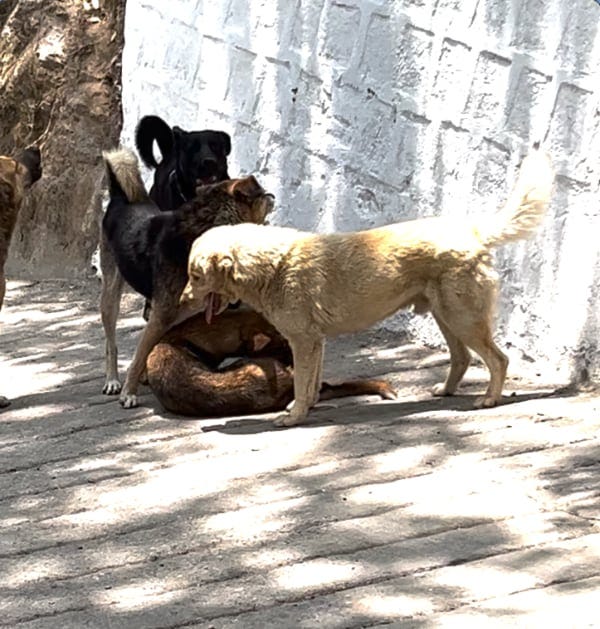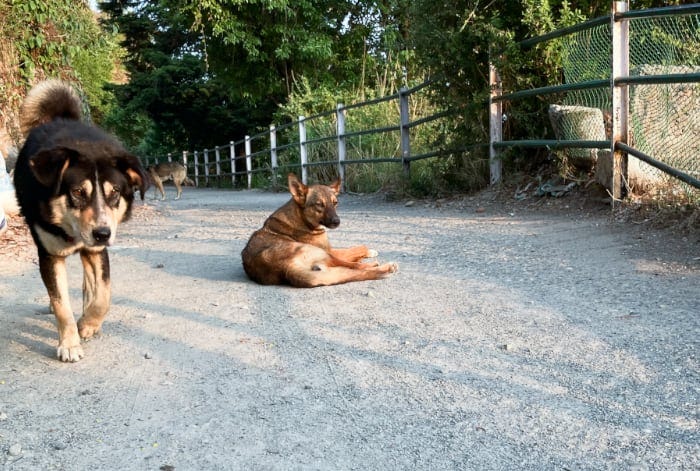Parvo: Respect It, Don’t Fear It
Vets Think We’re Under Appreciated
“Idiopathic” Epilepsy? Not So Fast…
Raw Milk: Fuel vs Fear
Raw Kefir Easy Peasy
RIP Dr. Ronald Schultz
Along the Natural Path
Seasonal Parvo Fear Campaign
Spring is here, the local news is running out of interesting stories…”Hey, how about puppies dying of a killer virus?”
“Yeah, let’s run with it! Are there scads of them?”
“Well, not scads but some…”
“Can you put some fear spin on it? We need more eyeballs!”
They’d like you to be concerned fearful about parvovirus.
KXAN in Austin tells us Texas leads the nation in parvo cases.
News 13 in Tucson wants you to know “several puppies” died.
A county shelter closes in North Carolina to clean up after an outbreak. “Sorry, you foundlings, we’re bleaching everything, you’ll just have to wait!”
“Parvovirus cases rise in Kansas City, Mo.” And even with treatment, 50% may die. 20 dogs were treated…
The urge for animal owners, as you might guess:
Vaccinate! We’ve got it ready for you, just be a good, compliant pet owner and VACCINATE, already! This is a virus, after all, and vaccines are the answer!”
Fear Sells (and spreading it socially is powerful!)
Here’s a real life example from my files.
Brittney wrote me, concerned about using homeopathic nosodes for the first time.
We have a 5.5 week boxer puppy and we are avid outdoor people. Will the Parvo/Distemper (nosode) regimen alternation of twice a week be sufficient for a puppy outside daily? That’s the only hard part of navigating how to implement homeopathy. Is there a time frame of Introducing him to the dirt/grass after starting the nosodes?”
I sensed her fear, maybe too acutely, and wrote back that no pup needs to be raised in a bubble. Socialization means meeting dogs, people in hats, going to new places, and once the nosode hits the mouth, he’s good to go out into the great big world.
Her response:
Thank you! He's been outside a lot but EVERYONE is freaking out about Parvo. I mean like he's going to die. Plus some of our friends run a small kennel and have lost a few pups to Parvo before 6 weeks.”
So, that’s what you’re up against?
Damn.
Fearful hoards, certain your pup will die without the blessed vaccines?
No wonder Brittney was concerned.
Another Reality
First, let’s get some facts out there on this very real viral disease. Then we’ll look at a very real homeopathic experience.
The virus is ubiquitous (basically, everywhere dogs are or have been)
It’s long lived in the environment (a tough survivor)
It can kill pups, after a bout of diarrhea and/or vomiting
It rarely affects adults. They’re immune by 9 months if they’ve lived in the world.
Treating pups means ER time, expense, and an iffy prognosis (they don’t all survive)
There’s a vaccine, by God, and only a fool would choose NOT to USE IT!
Okay, that last one? Conventional veterinary view, not mine nor that of my homeopathic colleagues.
I interviewed my friend and homeopathic vet colleague Dr. Todd Cooney on parvo on my podcast. He’s clearly on the front lines, and used to have a clinic that stunk of parvo diarrhea.
No more, since making the jump to homeopathy years ago.
To everyone’s benefit, he’s kept some data on his parvo cases.
Dr. Cooney revealed:
Vaccine failure for Parvo runs up to 40%
He can cure most cases homeopathically, but those who come already vaccinated? They have a higher chance of dying than those never vaccinated, under the same careful treatment. (Read that twice…)
His own practice population is free of parvo, for years now. He never vaccinates against this deadly disease.
His conventional colleagues in town refer parvo cases to Todd, as they know he’ll cure them, faster and more surely than they can.
He, like I did, prevents the disease effectively with homeopathic nosodes (safe, ultra diluted remedies made from disease discharges).
Don’t Buy the Fear Narrative
So, is parvo a disease to take seriously?
You bet.
But how you protect against it is up to you.
Make informed choices. When you do, the panic of others will bounce right off you.
I’ve got a short course for you that goes into detail on how to do this safely with homeopathy, immune support, and a really cool natural exposure protocol another homeopathic colleague brought to light some years back.
To see the entire curriculum and enroll, here’s your link: Smart Vaccine Alternatives Short Course.
p.s. If “experts” tell you nosodes don’t work, well, you’ll want to vet those experts. Even if they are vets, heh heh.
p.p.s. Breeders: Want to eliminate parvo from your worry list while you also eliminate a vaccine known to be immune suppressive? And known to fail, like a lot? Put parvo (and distemper) nosodes to work for you! You can start them as early as you like and protect your precious newbies without risk. I know some forward thinking breeders send them home with their pups…
Kick the fear under the bus where it belongs. It’s not going to help you raise better, more vital pups into amazing adults. Exercise your options.
Only 49% of vets…
Believe our profession is appreciated — survey
Is this a sign of our times?
Has my once lauded profession slid in the eyes of the public they serve?
It sure is different now than my early, very heady days of practice, when I couldn’t believe they were paying me to do this amazing work!
The survey was professionally done by Kynetec, for the German pharma company, Boehringer Ingelheim, to coincide with World Veterinary Day in late April.
The survey, conducted in March, was participated in by 1,056 companion animal, livestock, and equine veterinarians from the U.S., Japan, United Kingdom, France, Brazil, and Germany. The perceived levels of appreciation for the profession were relatively consistent across key types of veterinary teams—with only 48 percent of pet-focused (cats and dogs),55 percent of livestock, and 42 percent of equine veterinary professionals reporting their profession was appreciated. This is despite 75 percent of survey respondents reporting feeling “personally” appreciated by their client base.”
Wait. What does Boehringer Ingelheim make?
For animals, pesticides.
In the vet world, they are known for NexGard, aka afoxolaner, that’s been causing seizures and aggression in treated animals for years.
The class name of these drugs is Isoxazolines, and includes the miraculous killer Bravecto, which I warned about some years back. One bite of this chewable, and the fleas start to die within 2 hours and continue dying off for 12 weeks (!).
My article links to two FaceBlock pages that continue to get comments on NexGard and Bravecto.
We lost our 5yr old lab 2 weeks ago. Gave him 1 dose of Nexgard and 12-24hours later he collapsed in our yard and was dead within 30 seconds.
We had a necropsy done and turns out his lungs were full of liquid and blood, all other organs were fine. Pulmonary edema and one of the causes listed is toxins he didn’t fit any of the other causes. My pup was perfectly healthy, running, eating, playing until I gave Nexgard.” — Melanie, April 20, 2024
Dr. Michael Fox points out the problems with these poisons both vets and the FDA seem to be ignoring, for years.
See the connection?
The company conducting the survey and the German pharma giant both ignore this and try to paint the self sacrificing, often work/life imbalances of my profession in glowing terms.
Disconnect, as usual.
Might this be a reason why the vet profession is under appreciated?
How about pushing unnecessary vaccines?
An informal survey by a vet years ago found some 60% of my profession continue to push annual vaccinations on you.
A quick search on your fave search engine (NOT Google) will show many clinics lead with vaccines as a heralded service, many mentioning “annual” in their copy.
Published work in 1992 by veterinary immunologists should have put that to rest.
A practice that was started many years ago and that lacks scientific validity or verification is annual revaccination. Almost without exception there is no immunologic requirement for annual revaccination. Immunity to viruses persists for years or for the life of the animal…… Furthermore, revaccination with most viral vaccines fails to stimulate an anamnestic (secondary) response…. The practice of annual vaccination in our opinion should be considered of questionable efficacy…”
The vet associations weakly rallied around this message, but to little or no change in most practices.
Even “holistic” vets refused to back off, in many cases.
A Texas veterinarian who was a board member of the Texas State Board of Veterinary Medicine, said he,
…could vaccinate a client’s pet every week for twenty two years and nobody could tell him not to.”
So, more disconnect? More “profits over pets?”
Might this contribute to the lack of veterinary appreciation by the public?
Duh.
How about board certified vets lying about pet food and heart disease?
I mentioned this briefly in an earlier issue and the perps are both vets and Hill’s Pet Food (who taught us “nutrition” in vet school, and donated all the food our teaching hospital used at the U. of Missouri).
So, yeah, I can see why my colleagues think our profession is receiving less than glowing reviews.
And why, as a profession, suicide runs high.
I’ve got a crazy idea…
How about putting honesty and integrity back into veterinary practice?
Along with a healthy work/life balance (if that’s out of whack, burn out helps no one).
If you’re hoping for appreciation, you’ve got to show you deserve it.
And consumers of vet medicine?
You can and should always vote with your wallet.
Idiopathic? Again? C’mon
A word of caution: Idiopathic
This word is over used in medicine. If you hear it, immediately turn on your BS meter.
Are you familiar with it?
It means, “We just have no earthly idea what causes this disease. (But we want to sound smarter than ‘I dunno…’)”
The latest is “idiopathic epilepsy,” brought to us vets in a recent podcast of Clinician’s Brief.
Although seizures can be scary, managing idiopathic epilepsy doesn’t have to be. In this episode of Clinician’s Brief Partner Podcast, host Dr. Beth sits down with Dr. Fred Wininger to get answers on how to approach the seizing pet, tips for pet owner communication, and options in seizure management.”
Sorry, Beth and Fred, but we damn well know what causes seizures.
History has answers
Way back before the drugs that dumb them down were invented, homeopaths knew seizures often followed vaccination.
The well known repertory by James Tyler Kent lists “Convulsions, vaccination, after : Sil.” Dr. Richard Pitcairn, who taught me and many of my homeopathic colleagues, recognized not only silica but the remedy thuja to be an often necessary step along the path to curing epilepsy.
Both remedies are well known “vaccinosis” remedies, that word coined by British physician J. Compton Burnett way back when people were suffering grievously and chronically after small pox vaccination.
So, what’s a better operant word for epilepsy then?
Iatrogenic. It means caused by the doctor and his treatments.
But, but… We’ve got a new drug!
The Kbro Vet company who sells a drug to fix this nasty seizure disease of unknown cause (whoops! Your dog has epilepsy? Danged if we don’t know why!) assures us it’s incurable… But we’ve got your Drug For Life. And it’s only a once a day tasty chewable!
Kay, bro… but we’re on to you.
If you’ve been following Big Pharma in the human sphere, this sounds familiar, right?
Cure? Not in our wheelhouse, sorry!
I call that Modern Medicine’s Dirty Secret
Once on our drug, you’ll need to stay on it, or things will get worse.
Meh.
Homeopathy, in trained, experienced hands, can and does cure chronic disease.
That link above will help you find someone to work with.
Epilepsy is just one version of chronic disease, and I’ve cured it with homeopathy.
It’s not easy work, and every case is unique, but it is curable.
But, idiopathic? We’re not buying it!
Raw Milk and Allergy Protection

Raw milk is back in the news of late.
In both a good light and a fearful one.
Ya pays ya money and ya takes ya choice!
The author’s bias
First, I’m biased. I’ll admit it.
When I lived in Austin, I got the most amazing Jersey milk, full of great butterfat, that made my lattes sing, made amazing (raw) kefir, and before I knew better about sweets, made amazing smoothies.
In India now, that’s all changed, because I’ve watched cows being milked here, and it’s anything but clean. You definitely boil the milk here before consuming it in any form.
But, when I saw this research paper indicating raw milk conferred allergy protection, and beneficial gut changes, I was intrigued, to say the least.
The Research
“Raw Milk-Induced Protection against Food Allergic Symptoms in Mice Is Accompanied by Shifts in Microbial Community Structure” is the published work in the International Journal of Molecular Sciences.
It was well done research, comparing raw cow’s milk to pasteurized milk, raw skimmed milk, and a control of saline.
The test animals (mice, who aren’t that far from humans in many ways) were given the test substance for a mere 8 days before they were exposed to an antigen known to provoke symptoms.
Only those mice getting either raw whole or raw skimmed milk responded favorably. And, get this: they responded even more favorably 5 weeks later without continual feeding of the raw milk!
Their microbiomes shifted favorably, and the researchers think that may be a chief contributor to their positive non-response to the allergic challenge.
The pasteurized groups actually showed a worsening of their gut flora and worsening of their allergic response to the challenge compared to the saline control group!
From the researchers:
Current knowledge on the mechanism(s) underlying the allergy-protective effects of raw cow’s milk is still limited. It is hypothesized that the many immunomodulatory components present in raw milk create a regulatory environment favoring unresponsiveness upon allergen exposure [23]. Potential mechanisms of action are improved intestinal barrier function, the promotion of regulatory T-cell development, and modulation of the gut microbiome [23,24,25].
Let’s get practical
One of the allergies they speak about is the #1 reason dogs see vets: Atopic dermatitis, aka The Itch. Pet insurance data stretching back a couple decades confirm this.
That’s a big problem in humans as well, and if you’ve ever lived with a dog or cat or child with The Itch, you know what hell that is for all involved.
What’s common between the affected animals and the kids?
Vaccinations, at far greater rates than has historically been the case.
The Fear Mongers: Raw milk is dangerous!
The bird flu (aka H5N1, aka Highly Pathogenic Avian Influenza, HPAI) has been found in dairy cows, as you likely now know.
And, for at least four cats, it appears the milk from these cows was infective, as I pointed out in my last newsletter.
My friends at Collapse Life point out that, even after the bird flu/milk connection, there’s been a significant uptick in raw milk consumption!
If you’re a raw milk consumer, it’d be prudent to ask if your source herd is a closed herd. That means, they are raising their heifers to milk cows, not buying in “replacements” from other herds.
What we’ve seen to date is that cows shipped to other states brought H5N1 with them. Texas cows in huge “organic” dairies (in quotes as I’ve never trusted the huge dairies to be truly organic in their methods) appear to be the source.
You’ll always do better with small farmers for your raw milk sourcing. Herds of less than 100 cows, ideally, with plenty of pasture and bonus points if they’re certified organic.
Know your farmers, visit them (but ask first, as they may be a bit gun shy if they’re in states recently found to have positive bird flu cases in cows). The link above lists the states currently affected.
The wild card
As I mentioned last issue, it’s apparent that gain of function (GoF) research is underway on bird flu. That’s only ever got one aim: more infectivity, more serious disease.
It brings a question to my mind: why would a respiratory virus, influenza, concentrate in milk?
Doesn’t that strike you as odd?
Respiratory viruses fly through the air in respiratory secretions. To my (admittedly limited) knowledge, they’d normally not be spread via milk.
Knowing your source, try raw milk
Were I in America, especially Austin, I’d be back on the raw Jersey milk from my old source in a heartbeat.
And, if I had allergic, itchy pets, they’d be treated to raw kefir on a daily basis.
If you try this for your own itchy ones, please let me know if you see results.
There’s a reason the Amish don’t get asthma and allergies, and part of that is assumed to be raw milk consumption.
That, and early life exposure to the barns, the cows, the horses, and the soil.
From the linked research article:
A well-known example is the “farm effect” wherein children growing up on a farm have a lower risk of developing allergic diseases compared to children who are raised in the same rural area but not on a farm [9,10,11,12,13]. This beneficial “farm effect” has been mainly attributed to the consumption of raw, unprocessed cow’s milk [14,15,16,17,18,19]. Since the allergy-protective raw milk effect also has been observed in children not exposed to a farming environment [14,15,16], raw cow’s milk consumption could provide a potential natural solution for allergic diseases.”
And, of course, these kids got zero vaccines.
Tasty Tips: Raw kefir, easy method
I made this video from Austin some years back, where my source of real live kefir grains came from a friendly Austinite I found on Craig’s List.
I do a similar method in India where I live now, but I have to use milk that’s once brought to a boil and cooled completely. Warm or hot milk would kill the lively probiotics which you’re seeking from the kefir. My milk comes from a farmer here via my stainless steel container, and my kefir is incubated in glass now.
As mentioned above, I’d not hesitate to use raw milk throughout if I were back in America, and that’s what I’m demonstrating here.
The benefits are many, and kefir organisms have actually been found to set up housekeeping in your gut, unlike the simpler yogurt cultures which apparently pass on through. They sure do cling to my glass containers!
Pets, including cats, should have no issues with this (unlike pasteurized, homogenized milk) and the benefits of raw milk + complex cultures like this should be a boon to both the healthy and those suffering allergies.
You’re welcome!
p.s. here’s where it lives on YouTube.
RIP Ron Schultz, Ph. D.
It’s with great sadness that I share that we’ve lost a great researcher, near and dear to many in the veterinary world for his work as a veterinary immunologist.
You’ll see me quoting his work in various courses and web pages, as he was probably the first to make serious waves against the craziness called “annual vaccination.”
As he worked for several vaccine manufacturers over the years, he had to establish that their vaccines actually worked (efficacy) and were safe (he had concerns that led him to coach minimizing vaccines).
I remember well, as a newly minted homeopathic vet in 1993, meeting him during the AHVMA meeting between sessions. It was there he revealed the fact that both the 1 year and the 3 year rabies vaccines were identical. Two lots, studied for different lengths of time, but identical in content.
You may have physically left us, Ron, but your wisdom will live on and help to save animal suffering when thinking people apply it.
Along the Natural Path
The view above, which I enjoy every morning as the sun rises over the Himalayan front range, reminds me a bit of The Man Who Would Be King. Have you seen that movie? Sean Connery and Michael Caine in a great story by Rudyard Kipling. Highly recommended.
Of course, this hill station in Uttarakhand is not Shangrila or a lost kingdom, as the litter in the old growth forest/cemetery I hike in proves, but it’s a super healthy spot and my happy place for a couple months.
I take full advantage of the wilds, including some amazing golden raspberries that are going off. Sitting among moss, ferns, and towering conifers, it always feels like my microbiome is at its best here.
This gang was surrounding a young bitch who was probably in her first heat. She’s rightly figured out that, amid all the posturing and commotion from the five males around her, her best bet to avoid (probably yet another) mounting is just to lie down. Right in our driveway.
I stopped to watch for several minutes, and the males never once stopped barking. One false move, and the fangs were bared and the bark turned ugly and guttural. The most dominant male just stood over the bitch, with her shoulders between his forelegs, and his tail defiantly curled up over his back.
Her heat started the day before and took about 72 hours to wind down. This is what it looked like this morning, on the opposite side of the mountain I hike:
She’s in the same position but the males are back to sniffing around urine trails instead of in her face. Or rather, her tail end. The guy coming towards me was her dominant boyfriend yesterday, and I’m guessing his genes will show up in her litter in a couple of months.
This mighty forest dwelling leaf eating langur was just slightly less shy than the troupe he was traveling with, and sat long enough to allow a backside view:
When they are on the move, they are supremely good at leaping, kangaroo like, but in the branches, and usually high up, well out of reach.
These macaques are very fearful of them, and give them wide berth, which seems odd, as langur are herbivores.
These guys are much more agile, and can walk right across a telephone wire as well as hanging from the same wire and scurrying along upside down. Often with a baby clinging to Mom’s back or belly. They’re a bit put off by cameras and direct staring at them, so I don’t often get their pics.
Street dogs pull up to rest where ever there’s a free space. They all seem in pretty good shape, so people must feed them daily, though they are wanderers within their territories.
Blaring car horns and street noise just wash over them, with nary a paw twitch or an ear movement. Such is the bliss of deep sleep in all species.
Some of the humans are more of a pain:
It’s hard to appreciate in this short walk by clip I shot, but the woman had a horribly grating voice, singing loudly while her pony tailed partner beat his dholak loudly and sharply.
When I asked my friend if they put out a hat for tips, he explained this was a very different kind of “concert.” They’d park outside a shop in the bazaar, most likely a higher end shop than a hole in the wall outfit no one was shopping in.
Their goal? To make enough loud music noise as to drive away business from the shop, until the shopkeeper came out to pay them a bit of money!
“Eh, nice bizniz you got here! It’d be a shame if your customers all left, you know what I’m sayin?”
An Indian street protection racket!
Dogs have much more class. The animals are why I chose vet school over Single Species Med School.
Until next time, keep on making those wise decisions for the innocents in your care who depend on you.
Bring out your Vitamin N (“No.”) when appropriate and fear not. We can creatively work our way through the challenges that come our way when we stay centered and don’t buy into the divisiveness or the scare tactics.
Will Falconer, DVM
p.s. Have you joined my free Vital Animal Pack yet? I’ve got a sweet little library for you there including my Bach Flower Remedies for Animals course and several free reports.
p.p.s. Share this. Send some ripples out! Who knows how many animals and their people you’ll help?

















RIP Dr Ronald Schultz ❤️
Immunological memory is the ability of the immune system to quickly and specifically recognize an antigen that the body has previously encountered and initiate a corresponding immune response. Generally these are secondary, tertiary and other subsequent immune responses to the same antigen. Immunological memory is responsible for the adaptive component of the immune system, special T and B cells — the so-called memory T and B cells.
.
IgG antibodies are Y-shaped protein molecules that are produced by special white blood cells (B lymphocytes) in response to foreign substances (antigens) such as viruses or bacteria. Antibodies can attach to these viruses or bacteria, rendering them harmless and unable to penetrate healthy cells. They GO AWAY with time and could fall to a NEGATIVE level DOESN'T mean susceptible.
.
Total immunity against viral diseases includes:
1. Local IgA and IgM
2. Humoral immunity of IgG antibodies, both those present in the blood AND those that can be produced quickly when the antigen is present
3. Cellular immunity or MEMORY
4. Other mechanisms.
When we measure antibody titers, we are ONLY documenting the IgG antibodies present in the bloodstream.
.
The Immune System fires up when a pathogen, like a virus, enters the body. The pathogen releases a protein called an antigen, which calls into action the immune system’s special disease-fighting cells. "Called B and T lymphocytes", these cells NOT only destroy the virus, but they REMEMBER what it looked like so they can fend it off in the FUTURE.
.
IMMUNOLOGIC MEMORY allows the immune system to REMEMBER the antigens or organisms to which it has previously been exposed. MEMORY EFFECTOR B cells (long-lived plasma cells) and MEMORY T-cells specific to a virus, give long-term immunity against these diseases.
.
ADAPTIVE IMMUNITY.
.
The “Adaptive Immune Response" is younger than the “Innate Immune Response" in evolutionary terms and is more specific and considerably MORE POTENT in its effects.
.
The constituents of the adaptive immune response are the lymphoid cells. These include:
.
The T lymphocytes and the cytokine and chemokine messenger proteins released by these cells, which direct and REGULATE the adaptive immune response.
.
The B lymphocytes, which transform to the late-stage plasma cells that produce and secrete antibody.
.
The lymphoid cells of the adaptive immune response reside in, and circulate between, the various lymphoid tissues of the body (e.g. the lymph nodes, spleen and mucosal lymphoid tissues). In the adaptive immune response, antigen is first transported from a site of infection by a dendritic cell to the regional lymphoid tissue. That dendritic cell in turn activates "Antigen-Specific T lymphocytes," which further activate Antigen-Specific B lymphocytes.”
.
These activated, Antigen-Specific lymphocytes must then be mobilized from the regional lymphoid tissue and sent to the site of infection, a process that involves these cells moving into the lymphatic and blood circulation and interacting with the endothelial lining of blood vessels.
.
Once these cells reach the site of infection, they are able to mount a full-scale ‘EFFECTOR’ response, which is considerably STRONGER than that permitted by innate immunity. As these processes take some time to occur (in the order of 4–7 days), there is a delay before adaptive immunity ‘takes over’ from the innate form of defence.
.
The final component of Adaptive Immunity is the development of a “REGULATORY RESPONSE" that will "SWITCH OFF" the system when it is NO LONGER REQUIRED (i.e. when the pathogen has been ELIMINATED) so as NOT to cause DAMAGE to normal body tissue.
.
HOWEVER, once this is achieved, the immune system retains the “MEMORY” of that immune response.
IMMUNOLOGICAL MEMORY is another key feature of the Adaptive Immune Response. MEMORY allows the generation of a much MORE effective SECONDARY IMMUNE RESPONSE (Anamnestic MEMORY Response) if that same antigen is EVER RE-ENCOUNTERED.
…
Could you use raw goat milk to make kefir and give that to dog?